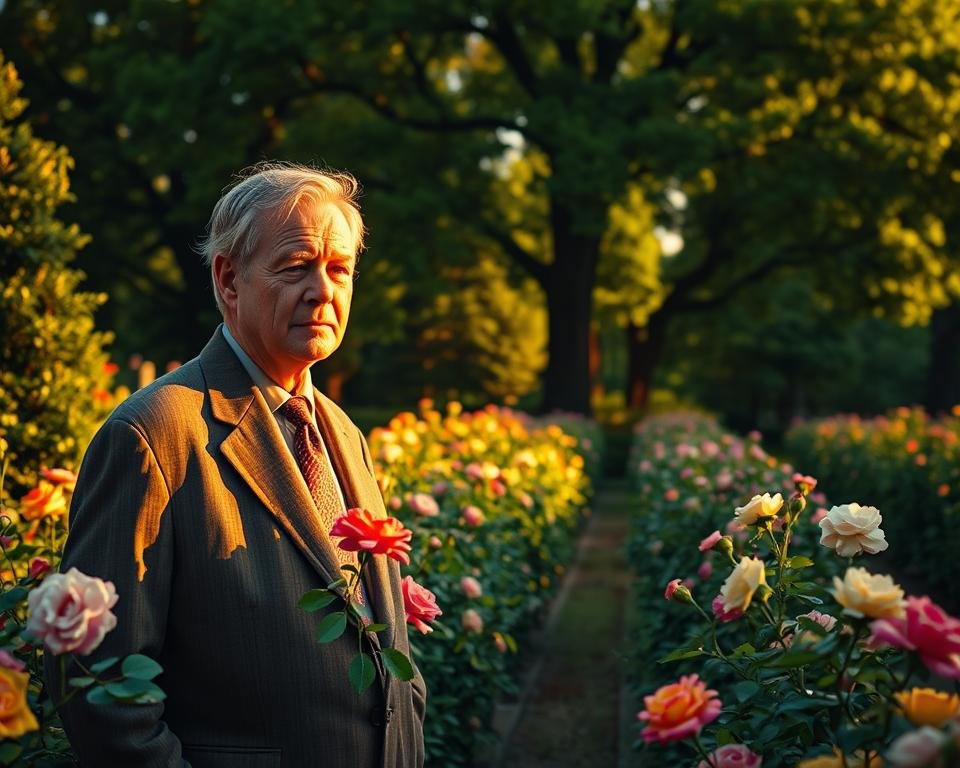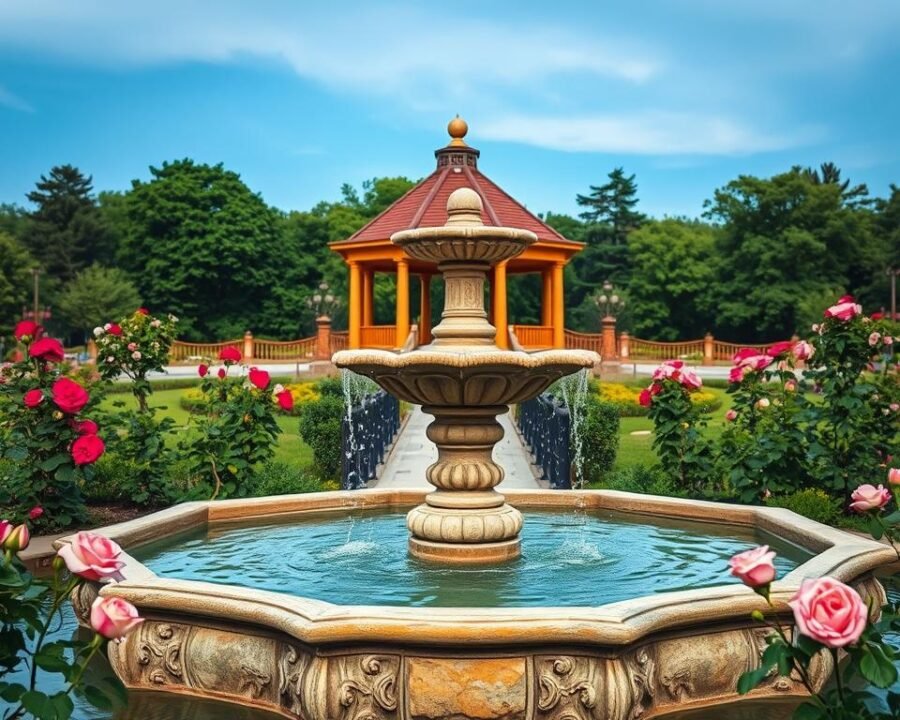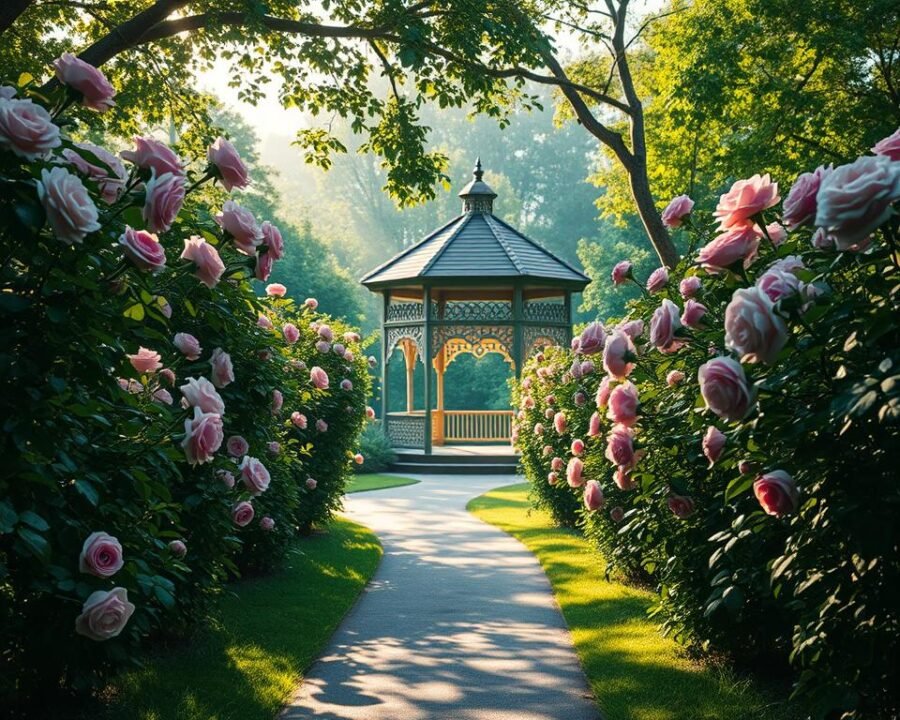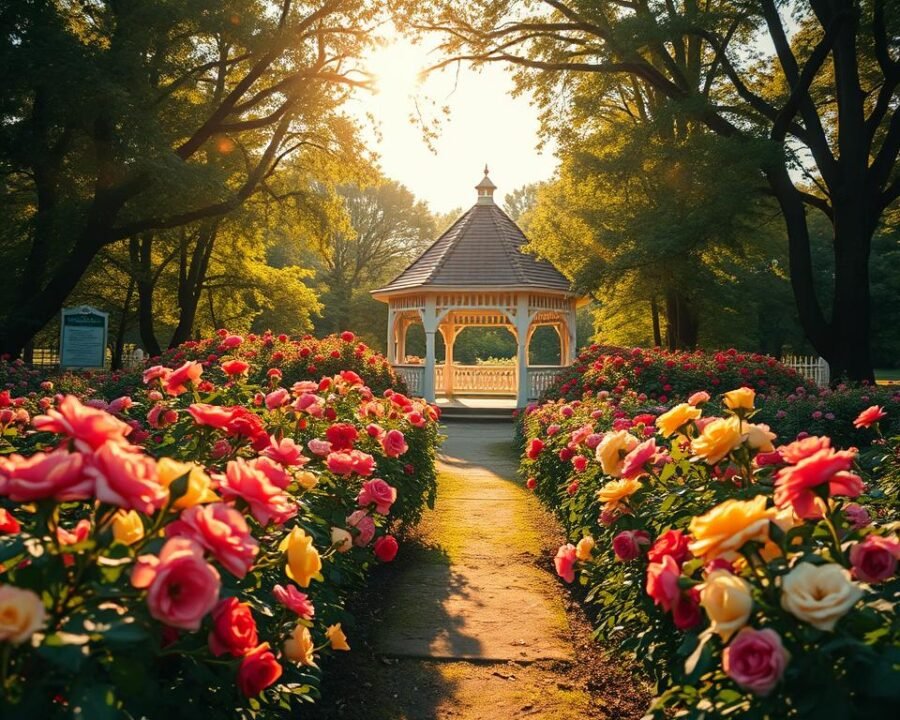Imagine stepping into a place where time slows down, and nature’s beauty takes center stage. For over a century, the Lyndale Park Rose Garden has been a cherished retreat in Minneapolis. Since its founding in 1908, it has grown into a historic landmark, captivating visitors with its stunning displays and serene atmosphere.
This garden is not just a feast for the eyes but also a testament to horticultural excellence. As the second oldest public rose garden in the U.S., it boasts over 3,000 roses representing more than 250 varieties. Each bloom tells a story, and during peak season, the garden transforms into a sea of 60,000 flowers, creating a breathtaking spectacle.
Nestled on a gentle slope overlooking Lake Harriet, the garden offers more than just visual appeal. It serves as both an aesthetic haven and an educational resource, inspiring gardeners and nature lovers alike. Since 1946, it has also been an All-America Rose Selections test site, contributing to the development of new rose varieties.
Whether you’re a local or a visitor, the Lyndale Park Rose Garden invites you to experience its timeless charm. Its proximity to other gardens and Lake Harriet amenities makes it a must-visit destination in Minneapolis.
Key Takeaways
- Founded in 1908, it’s one of the oldest public rose gardens in the U.S.
- Features over 3,000 roses and 250+ varieties.
- Located on a scenic slope overlooking Lake Harriet.
- Peak season showcases 60,000 blooms.
- Designated as an All-America Rose Selections test site since 1946.
- Combines beauty with educational opportunities.
- Close to other attractions in Lyndale Park.
Introduction to Lyndale Park Rose Garden
Nestled within the scenic Lake Harriet Park complex, this historic gem offers a blend of beauty and education. As part of the broader Minneapolis parks system, it has been a cherished destination for over a century. Its location near the lake adds to its charm, making it a must-visit spot for nature enthusiasts.
When it first opened in 1908, the garden featured 62 rectangular beds, meticulously arranged to showcase a variety of blooms. This original layout remains a key feature, highlighting the garden’s historic roots. Along the perimeter, floribunda and shrub roses create vibrant borders, adding depth and color to the space.
Theodore Wirth, a visionary in landscape design, envisioned this space as both an aesthetic retreat and an educational resource. His dual-purpose approach has shaped the garden’s identity, making it a model for public green spaces across the garden United States. Today, it continues to inspire visitors with its timeless appeal.
As a free public attraction, the garden welcomes everyone to explore its beauty. Clear signage and recent improvements, like the 1988 fountain patio, enhance the visitor experience. These updates reflect the ongoing commitment to preserving this historic site.
This garden is more than just a beautiful space—it’s a testament to the Minneapolis parks system’s horticultural legacy. Whether you’re a local or a visitor, it offers a unique opportunity to connect with nature and history in one of the city’s most beloved locations.
The History of Lyndale Park Rose Garden

The story of this historic space begins with a visionary leader. Theodore Wirth, who became Minneapolis park superintendent in 1906, had a bold idea. He envisioned creating gardens that would not only beautify the city but also educate its residents. His 1906 report to the park board recommended spaces dedicated to “educational plant life,” laying the groundwork for what would become a horticultural masterpiece.
Wirth’s vision was inspired by his earlier work in Hartford, Connecticut, where he established the first municipal rose garden in the U.S. He brought this concept to Minneapolis, collaborating with florist Louis Boeglin from 1907 to 1940. Together, they transformed the idea into reality, completing the original layout in 1908. Boeglin’s expertise was crucial in selecting and cultivating the diverse varieties that would define the space.
Despite its beauty, the garden faced early challenges. Public awareness was slow to grow, with only modest visitor numbers in its initial years. By 1914, however, its reputation began to spread, drawing more admirers. The garden’s significance was further cemented in 1946 when it was designated as an All-America Rose Selections test site, contributing to the development of new rose varieties.
Another milestone came in 1947 when Frank Heffelfinger donated a fountain, adding a new focal point to the space. This gift symbolized the community’s growing appreciation for the garden’s role in the city’s cultural and horticultural heritage. Today, the garden stands as a testament to Wirth’s vision and the collaborative efforts that brought it to life.
Features of Lyndale Park Rose Garden

Step into a world where history and horticulture intertwine beautifully. This space is a testament to thoughtful design and natural diversity. From its carefully preserved layout to its iconic centerpiece, every feature tells a story.
Rose Varieties and Layout
The garden’s design is a blend of tradition and innovation. Its original 62-bed geometric garden layout remains intact, showcasing a variety of roses. Visitors can admire hybrid tea roses, grandifloras, and floribundas, each adding unique charm.
In 1924, a 1,000-foot-long perennial and annual garden was added, offering seasonal blooms that change throughout the year. The 1929 rock garden, crafted with Oneonta dolomite stones, adds a rugged contrast to the floral beauty.
The Heffelfinger Fountain
At the heart of the garden stands the Heffelfinger Fountain, a gift from Frank Heffelfinger in 1947. Inspired by Florentine design, this fountain serves as a focal point, blending artistry with nature. Its installation marked a significant moment in the garden’s history.
Surrounding the fountain, the Peace Garden transformed an abandoned rock garden into a serene space. Nearby, the Bossen Lane wetlands and bird sanctuary add ecological depth, making this a haven for both plants and wildlife.
| Rose Type | Characteristics |
|---|---|
| Hybrid Tea Roses | Large, single blooms on long stems |
| Grandifloras | Clusters of blooms, taller growth |
| Floribundas | Abundant, smaller blooms in clusters |
Whether you’re drawn to the hybrid tea roses or the tranquil sounds of the Heffelfinger Fountain, this space offers something for everyone. Its blend of history, design, and natural beauty makes it a must-see destination.
Visiting Lyndale Park Rose Garden

Plan your visit to a serene destination that blends history and horticulture. Whether you’re a first-time visitor or a regular, knowing the garden hours, parking options, and accessibility features will ensure a smooth experience.
Garden Hours and Best Times to Visit
The garden is open seasonally from spring through fall, welcoming visitors daily from dawn to dusk. For the best experience, consider arriving early in the morning or on weekdays. These times are ideal for photography, as the soft light enhances the vibrant colors of the blooms.
Parking and Accessibility
Parking is available nearby, with options for both short-term visitors and those with an annual parking permit. Designated accessible spaces and smooth pathways ensure the garden is welcoming to all. ADA-compliant features make it easy for everyone to explore the space comfortably.
For those arriving by public transit, the Lake Harriet Park trolley is a convenient option. Bike trails also connect to the area, offering an eco-friendly way to reach the garden. Restrooms and water fountains are located nearby for added convenience.
With its proximity to the west shore peninsula of Lake Harriet Park, the garden is part of a larger network of attractions. Whether you’re planning a quick visit or a full day of exploration, this destination offers something for everyone.
Events and Activities at Lyndale Park Rose Garden
Discover a vibrant hub of culture and learning in the heart of Minneapolis. This iconic destination has long been a stage for creativity and community engagement, offering a mix of historic performances and modern workshops. Whether you’re drawn to lively entertainment or hands-on learning, there’s something for everyone.
Outdoor Concerts and Pageants
From 1917 to 1941, the space hosted annual playground pageants, drawing up to 40,000 visitors. These events featured elaborate costumes and lakefront staging, creating unforgettable spectacles. A 1930 proposal even envisioned an 18,000-seat amphitheater to accommodate the growing crowds.
Today, the tradition continues with modern outdoor concerts held on the hillside. These performances bring the community together, offering a chance to enjoy music in a picturesque setting. Whether you’re a fan of classical tunes or contemporary beats, these events are a must-see.
Educational Programs
For those eager to learn, the space offers a variety of educational programs. Master Gardener-led workshops teach rose care and horticulture, while photography classes and plein air painting sessions inspire creativity. Seasonal volunteer opportunities also allow visitors to contribute to garden maintenance.
Annual rose pruning demonstrations are a highlight, providing practical tips for gardeners of all levels. These programs not only educate but also foster a deeper connection to nature. To explore more about these offerings, visit the official website.
Lyndale Park Rose Garden in Different Seasons
Every season brings a unique charm to this historic space, offering visitors a year-round retreat. From the vibrant spring blooms to the serene winter charm, each visit feels like a new experience. Whether you’re a photographer, nature lover, or simply seeking tranquility, there’s always something to admire.
Spring and Summer Blooms
As the frost melts away, the garden awakens with life. By May, the perennial border begins to flourish, showcasing over 10,000 plants. June marks the peak season, with 60,000 flowers painting the landscape in vivid colors. This is the perfect time for photography, as the soft sunlight enhances the beauty of the blooms.
The rediscovered rock garden adds a touch of alpine beauty, with unique plants thriving in the summer warmth. Visitors can stroll through the perennial border, marveling at the diversity of flora. For more details on seasonal highlights, visit the official website.
Fall and Winter Charm
As autumn arrives, the garden transforms once again. Late-blooming roses contrast beautifully with the golden fall foliage, creating a picturesque scene. Winter brings its own magic, with snow-dusted arches and evergreen structures offering stunning photography opportunities.
The adjacent bird sanctuary remains active year-round, making it a haven for birdwatchers. Winter berry displays add pops of color to the snowy landscape, enhancing the garden’s winter charm. Whether you’re capturing the frosty arches or enjoying the serene atmosphere, this space is a delight in every season.
Nearby Attractions and Amenities
Just a short stroll away, you’ll find a variety of attractions that complement your visit. From scenic trails to vibrant gardens, the area offers something for everyone. Whether you’re exploring solo or with family, these nearby spots are worth adding to your itinerary.
Lake Harriet Park
One of the most popular destinations is Lake Harriet Park, known for its picturesque views and recreational activities. The park features a historic bandshell, where outdoor concerts fill the air with music during the summer months. Visitors can also enjoy the sandy beach, perfect for a relaxing day by the water.
Walking paths circle the lake, offering a peaceful way to explore the area. The historic trolley, operational since the early 1900s, adds a nostalgic touch to your visit. For birdwatchers, the Bossen Trail’s wetland boardwalks provide a chance to spot local wildlife.
Other Gardens in the Area
Adjacent to the main attraction, you’ll find the Peace Garden, a serene space featuring international flora themes. This garden is a testament to unity and diversity, with plants representing cultures from around the world. It’s a quiet retreat for reflection and appreciation of nature’s beauty.
The perennial border gardens stretch over 1,000 feet, showcasing a stunning display of seasonal blooms. Rediscovered in the 1980s, the rock garden adds a rugged charm with its unique plant varieties. Together, these gardens create an interconnected network of natural wonders.
Whether you’re drawn to the tranquil Peace Garden or the vibrant perennial border gardens, the area offers endless opportunities to connect with nature. Each spot tells a story, making your visit both enriching and memorable.
Conclusion
As a cherished part of Minneapolis, this historic garden offers more than just beauty—it’s a living piece of history. Combining its legacy as a historic site with its role as a living museum, it invites visitors to explore its timeless charm. Best of all, admission is free, making it accessible to everyone year-round.
Each season brings a new experience, from vibrant blooms in spring to serene winter landscapes. Multiple visits allow you to fully appreciate its ever-changing beauty. Located near other cultural attractions, it’s a perfect addition to any Minneapolis itinerary.
Don’t forget to check the event calendar for workshops and activities. Whether you’re a first-time visitor or a local, this Minneapolis gem promises a memorable experience. Plan your visit today and discover why the Lyndale Park Rose garden remains a beloved destination.
